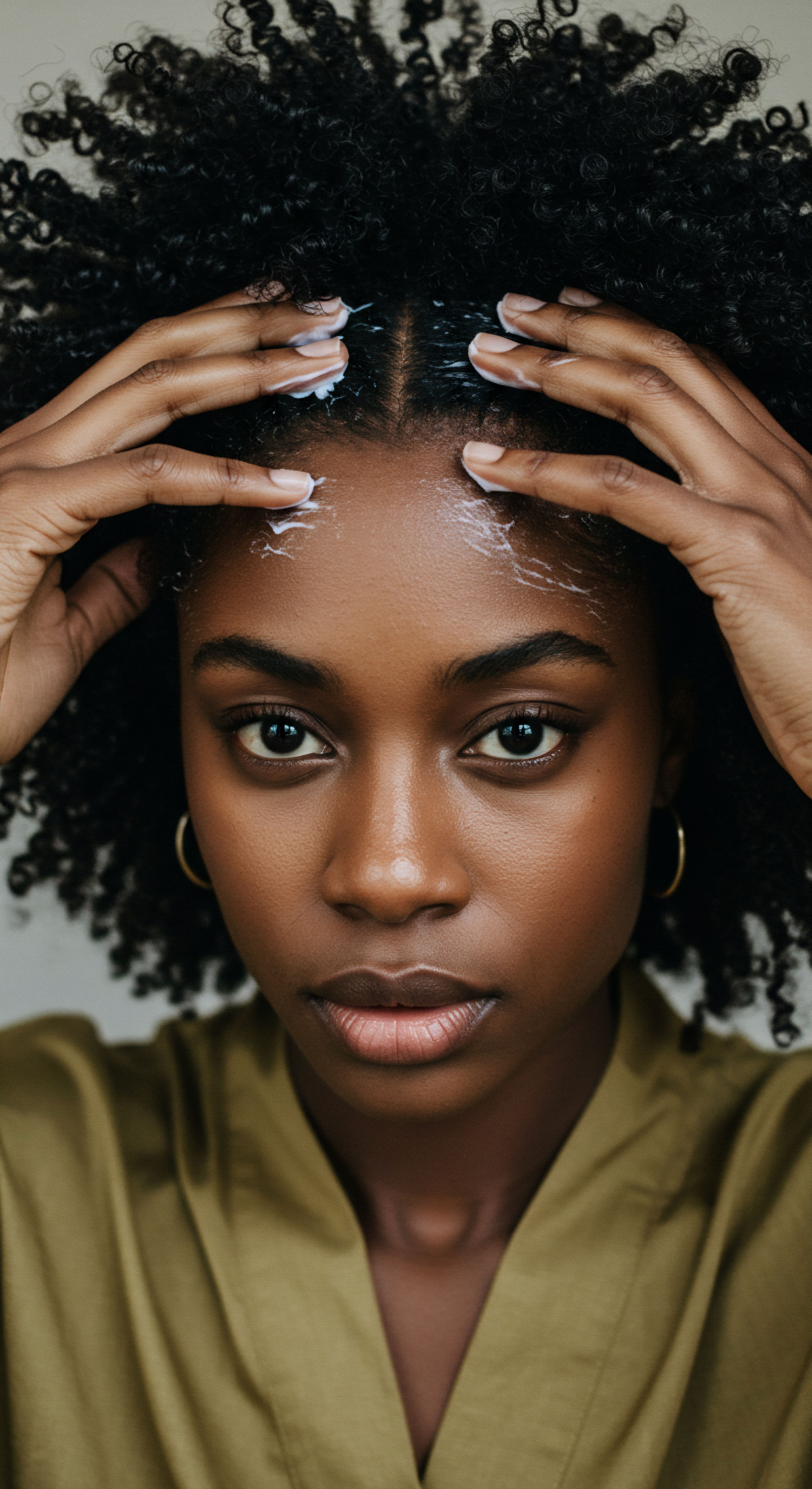
Roots
The quiet hours of slumber, often perceived as a mere pause in our bustling lives, hold a profound secret for the very foundation of our being ❉ the scalp. Far from a dormant period, nighttime is a symphony of cellular renewal, a dedicated workshop where the delicate tissues of the scalp diligently mend and revitalize. For those with textured hair, this nocturnal restoration carries an even deeper significance, influencing not only the vitality of each strand but the underlying health of the skin that cradles them. Understanding this intrinsic link between rest and scalp vitality offers a fresh perspective on what it means to truly care for our crowns.
At the heart of this nightly revitalization lies the skin’s own biological clock, a remarkable internal timekeeper known as the Circadian Rhythm. This rhythm orchestrates a precise ballet of cellular activities, ensuring that during the day, our scalp cells stand as vigilant protectors against environmental aggressors like UV radiation and pollutants. As twilight descends, a shift occurs, signaling a transition from defense to deep repair. This is when the scalp’s cells begin their most intensive work, a period of heightened activity where DNA repair mechanisms are at their peak, diligently correcting the day’s wear and tear.
The scalp’s internal clock orchestrates a precise cellular rhythm, shifting from daytime protection to nighttime repair.
The very process of cell division, known as Mitosis, accelerates dramatically during sleep, particularly in the deep, slow-wave stages. This burst of cellular activity ensures that old, damaged cells are replaced with fresh, healthy ones, maintaining the integrity and resilience of the scalp’s surface. This turnover is not a passive event; it is a meticulously coordinated effort, driven by a cascade of biochemical signals. The hair follicles themselves, deeply embedded within the scalp, are intimately connected to this rhythm.
They possess their own circadian clock genes, which play a significant role in regulating the cyclical phases of hair growth. This biological timing influences when hair follicles are most active in their growth phase, known as anagen, and when they transition to resting or shedding phases.

The Architecture of Scalp Health
To truly grasp the impact of sleep, we must consider the intricate architecture of the scalp. It is more than just a surface; it is a complex ecosystem comprising various cell types, each with specific roles in maintaining health and supporting hair growth. The outermost layer, the Epidermis, constantly renews itself, forming a protective barrier.
Beneath this lies the dermis, rich in collagen and elastin, providing structural support and housing the hair follicles, sebaceous glands, and blood vessels. These components work in concert, and their optimal function relies heavily on adequate rest.
- Keratinocytes ❉ These cells make up the majority of the epidermis and are responsible for producing keratin, a protein that provides strength and waterproofing. Their nightly renewal is paramount for a robust skin barrier.
- Fibroblasts ❉ Situated in the dermis, these cells produce collagen and elastin, the proteins that give skin its firmness and elasticity. Sleep directly influences their activity and the quality of the collagen they produce.
- Hair Follicle Stem Cells ❉ These specialized cells, nestled within the hair follicle, are the powerhouses of hair regeneration. Their activation and proliferation are influenced by circadian rhythms, directly affecting the hair growth cycle.
Consider a fascinating observation ❉ a study revealed that good sleepers experienced a remarkable 30% Greater Skin Barrier Recovery compared to poor sleepers after controlled skin stripping. This quantifiable difference underscores how essential uninterrupted rest is for the scalp’s capacity to heal itself, to re-establish its protective shield against external stressors. For textured hair, where moisture retention is often a primary concern, a compromised scalp barrier can lead to increased water loss, dryness, and a heightened vulnerability to irritation, directly affecting the health and appearance of the hair.

Hormonal Orchestration of Repair
The night also serves as a crucial period for hormonal recalibration, with several key hormones playing a direct part in scalp cell repair. Among the most prominent is Human Growth Hormone, or HGH. This powerful peptide hormone is released in increased amounts during the deep stages of non-REM sleep. HGH acts as a cellular architect, stimulating the growth, reproduction, and regeneration of cells throughout the body, including those in the scalp.
Its presence is vital for the synthesis of Collagen, the structural protein that maintains the skin’s youthful plumpness and elasticity. Without sufficient HGH, collagen production falters, potentially leading to a scalp that feels less resilient and more prone to issues.
Conversely, the levels of Cortisol, often termed the stress hormone, naturally decline during sleep. This nightly dip in cortisol is crucial, as sustained high levels can lead to a breakdown of collagen and elastin, contributing to inflammation and weakening the scalp’s delicate barrier. When sleep is consistently cut short, cortisol levels remain elevated, creating an environment that hinders repair and can exacerbate existing scalp conditions. The balanced interplay of these hormones during a full night’s rest provides the ideal biochemical backdrop for scalp cells to perform their essential restorative duties, laying the groundwork for vibrant, healthy hair.

Ritual
Moving beyond the hidden cellular processes, the nightly ritual of preparing for rest holds practical wisdom for the health of our scalp and hair. It is a moment to transition from the day’s demands to a period of conscious care, understanding that our actions before sleep can profoundly influence the scalp’s restorative work. For textured hair, where delicate structures require mindful handling, these evening practices are not simply about convenience; they are acts of preservation, contributing directly to the scalp’s ability to mend and rejuvenate. This segment offers a gentle guide through the purposeful steps that can elevate your nighttime routine into a sanctuary for your scalp.

The Nighttime Sanctuary Protecting Hair
The environment in which we sleep, and how we prepare our hair for it, significantly influences the scalp’s capacity for repair. The physical act of tossing and turning, the friction against harsh fabrics, and even the ambient humidity can all contribute to moisture loss and mechanical stress on the hair and scalp. This is where the wisdom of protective measures comes into its own.
A cornerstone of nighttime hair care, particularly for textured hair, is the use of Bonnets or silk/satin pillowcases. The history of bonnets for hair protection stretches back centuries, with roots in Ancient Egypt and a deep cultural significance within African heritage. Originally serving practical purposes like protecting hair from the elements and maintaining intricate styles, bonnets became an essential tool in textured hair care to prevent breakage and moisture loss.
| Benefit Category Reduced Friction |
| Impact on Scalp and Hair Minimizes tangling, breakage, and mechanical stress on hair strands and scalp, preserving the cuticle layer. |
| Benefit Category Moisture Retention |
| Impact on Scalp and Hair Unlike cotton, silk and satin do not absorb moisture from hair, helping the scalp maintain its natural hydration and preventing dryness. |
| Benefit Category Temperature Regulation |
| Impact on Scalp and Hair Allows the scalp to breathe, preventing overheating that could disrupt its natural processes. |
| Benefit Category Preservation of Styles |
| Impact on Scalp and Hair Extends the life of hairstyles, reducing the need for daily manipulation that can stress the scalp. |
When the scalp is permitted to rest without constant friction or excessive moisture evaporation, its cellular repair mechanisms can operate with greater efficiency. The scalp’s barrier function, which can be compromised by inadequate sleep, benefits immensely from this protected environment. By reducing external stressors, we create an optimal setting for the release of growth hormones and the acceleration of cell turnover, both critical for scalp health.
Conscious nighttime practices, such as using protective head coverings, directly support the scalp’s delicate repair mechanisms.

Holistic Influences on Hair Wellness
Beyond direct hair protection, the broader spectrum of holistic practices before sleep contributes to a scalp environment conducive to repair. The quality of our rest is not merely about duration; it encompasses the depth and restorative nature of that sleep. Factors like stress levels, dietary choices, and even exposure to light can influence the body’s ability to enter the deep sleep stages where scalp cell repair is most active.
- Stress Reduction ❉ High levels of the stress hormone cortisol, as noted earlier, can hinder collagen production and promote inflammation, directly impacting scalp health. Incorporating calming activities before bed, such as gentle stretching, reading, or a warm bath, can help lower cortisol levels and signal to the body that it is time to wind down.
- Nutritional Support ❉ The body needs specific building blocks for cellular repair. A balanced diet rich in proteins, vitamins, and minerals supports the synthesis of collagen and the proper functioning of hair follicles. While direct topical application of nutrients is important, internal nourishment provides the foundational support for scalp health.
- Light Exposure Management ❉ Exposure to blue light from electronic devices before bed can suppress the body’s natural production of melatonin, the hormone that regulates sleep-wake cycles and also possesses antioxidant properties beneficial for hair follicles. Creating a dim, peaceful environment signals to the body that it is time for rest and repair.
The seemingly simple act of preparing for sleep transforms into a sophisticated ritual, acknowledging the intricate dance between our daily habits and the profound, silent work of our scalp cells. By honoring this period with deliberate care, we empower the scalp to fully engage in its nightly regeneration, paving the way for healthier, more vibrant textured hair.

Relay
To truly comprehend the profound relationship between sleep duration and scalp cell repair, we must journey beyond the surface, delving into the intricate biological mechanisms and the broader contextual influences that shape this nocturnal regeneration. How does the body, with such precise timing, orchestrate the mending of its epidermal canvas while we drift into unconsciousness? This exploration requires a scientific lens, examining the interplay of molecular signals, genetic programming, and systemic factors that collectively determine the efficacy of scalp repair during rest. It also prompts us to consider the subtle yet powerful ways our modern lives intersect with ancient biological rhythms, sometimes creating a discord that echoes in the very vitality of our hair.

The Cellular Symphony of Nighttime Repair
The scalp, like the rest of the skin, undergoes a sophisticated program of repair and renewal during sleep, a process governed by its intrinsic circadian clock. This internal timekeeper ensures that specific cellular functions are upregulated at night. For instance, DNA Repair Mechanisms within scalp cells are most active during the hours of darkness, working to correct damage accumulated from daytime exposure to UV radiation and environmental pollutants. This is not a random occurrence; it is a finely tuned biological imperative.
A critical aspect of this nocturnal activity is the increased production of proteins vital for skin integrity. Collagen Synthesis, for example, significantly ramps up during deep sleep stages. Collagen, the primary structural protein of the dermis, provides firmness and elasticity to the scalp.
When sleep is consistently insufficient, the body’s ability to produce new, healthy collagen is compromised, leading to a scalp that may feel less supple and more vulnerable to environmental stressors. This can manifest as reduced skin elasticity and potentially affect the anchoring of hair follicles.
Beyond structural proteins, sleep influences the production of various signaling molecules, including Cytokines. These small proteins play a pivotal role in cellular communication and immune responses. Proinflammatory cytokines, such as interleukin (IL)-1, IL-2, IL-6, and tumor necrosis factor (TNF)-α, increase at night, promoting sleep and also playing a role in wound healing and tissue repair. Conversely, anti-inflammatory cytokines are elevated upon awakening.
A disruption in sleep patterns can skew this delicate balance, leading to a state of chronic low-grade inflammation in the scalp. This inflammatory state can undermine the repair processes, potentially exacerbating conditions like dryness, irritation, and even contributing to hair thinning by creating a hostile environment for hair follicles.

How Does Sleep Duration Affect Hair Follicle Health?
The hair follicle itself is a marvel of regenerative biology, cycling through distinct phases of growth (anagen), regression (catagen), and rest (telogen). The precise timing and duration of these phases are influenced by systemic factors, including the sleep-wake cycle. The circadian clock genes, present within the hair follicles, directly regulate the proliferation of hair follicle stem cells, which are the driving force behind hair growth.
One particularly intriguing aspect is the role of Melatonin. While primarily known as the sleep-regulating hormone, melatonin is also a powerful antioxidant and has been shown to have direct effects on hair follicles. It interacts with melatonin receptors found on hair follicle cells, potentially extending the anagen phase, meaning hair stays in its growth phase for a longer period. This suggests a dual benefit ❉ melatonin not only aids in achieving restorative sleep, which indirectly supports scalp health, but its direct presence within the scalp can actively promote hair growth and density, particularly in conditions like androgenetic alopecia.
Melatonin, the sleep hormone, actively extends the hair’s growth phase while protecting follicles from oxidative stress.
A compelling study published in the American Journal of Physiology demonstrated the tangible impact of sleep restriction on wound healing. In healthy adults, a relatively modest sleep restriction (72 hours with only 2 hours of sleep nightly) significantly delayed skin barrier recovery in an experimental wound model. Skin barrier restoration took 5.0 ± 0.9 Days for sleep-restricted individuals compared to 4.2 ± 0.9 Days for those with adequate sleep (P = 0.02).
This finding is crucial because the scalp’s skin barrier is constantly under subtle assault from styling, environmental factors, and even daily washing. A delayed recovery means a longer period of vulnerability, making the scalp more susceptible to moisture loss, irritation, and potential infection, which can in turn negatively impact hair follicle function and overall hair health.

The Interconnected Web of Well-Being
The impact of sleep duration on scalp cell repair extends beyond isolated biological pathways; it is deeply interwoven with overall physiological and psychological well-being. Chronic sleep deprivation elevates systemic inflammation, compromises immune function, and disrupts metabolic processes, all of which indirectly but profoundly affect the scalp. The body’s resources are finite, and when continually diverted to manage stress responses or compensate for inadequate rest, less energy remains for optimal cellular regeneration in areas like the scalp.
Furthermore, the intricate connection between the skin, the nervous system, and the endocrine system means that prolonged sleep disturbances can create a cycle of imbalance. Increased levels of stress hormones, coupled with dysregulated cytokine production, can contribute to a less hospitable environment for healthy hair growth and scalp repair. This understanding moves us beyond viewing sleep as a luxury and positions it as a fundamental pillar of trichological health, a silent yet powerful force that underpins the very resilience and vibrancy of textured hair.

Reflection
As the soft light of dawn touches the horizon, a profound transformation has quietly unfolded upon our scalps during the hours of repose. The gentle yet powerful rhythms of sleep have meticulously tended to the delicate landscape beneath our hair, mending, renewing, and preparing it for the day ahead. This unseen work, a testament to the body’s innate wisdom, reminds us that true hair vitality begins not with external adornments, but with the quiet, consistent care we offer ourselves each night. The connection between restful slumber and a flourishing scalp is an invitation to listen more closely to our body’s subtle whispers, honoring the deep, restorative power of rest as the ultimate act of self-preservation for our textured crowns.

References
- Oyetakin-White, P. et al. “Does poor sleep quality affect skin ageing?” Clinical and Experimental Dermatology, vol. 40, no. 5, 2015, pp. 561-569.
- Kanda, N. and Watanabe, S. “Regulatory roles of sex hormones in cutaneous biology and immunology.” Journal of Dermatological Science, vol. 38, no. 1, 2005, pp. 1-7.
- Fischer, T.W. et al. “Topical Melatonin for Treatment of Androgenetic Alopecia.” International Journal of Trichology, vol. 4, no. 4, 2012, pp. 236-245.
- Besedovsky, L. Lange, T. and Haack, M. “The Sleep-Immune Crosstalk in Health and Disease.” Physiological Reviews, vol. 99, no. 3, 2019, pp. 1325-1380.
- Sapolsky, R.M. Romero, L.M. and Munck, A.U. “How do glucocorticoids influence stress responses? Integrating permissive, suppressive, stimulatory, and preparative actions.” Endocrine Reviews, vol. 21, no. 1, 2000, pp. 55-89.
- Van Cauter, E. and Plat, L. “Physiology of growth hormone secretion during sleep.” Journal of Pediatrics, vol. 128, no. 5 Pt 2, 1996, pp. S32-S37.
- Grover, C. and Khurana, A. “Telogen Effluvium.” Indian Journal of Dermatology, Venereology, and Leprology, vol. 79, no. 5, 2013, pp. 591-603.
- Patel, N. Aschenbrenner, D.S. and Dhurat, R. “Sleep Deprivation as a Stressor in Telogen Effluvium.” Sleep Medicine Reviews, vol. 45, 2019, pp. 61-72.
- Albrecht, L. Fortin, G. and Ray, D.W. “Stress-related hair loss and alopecia areata in a sleep-deprived population.” Journal of the American Academy of Dermatology.
- Oh, J.W. et al. “A Guide to Studying Human Hair Follicle Cycling in Vivo.” Journal of Investigative Dermatology, vol. 136, no. 1, 2016, pp. 34-44.
- Duan, L. and Silverberg, J.I. “A detailed framework illustrating factors mediating the bidirectional relationship between chronic inflammatory skin diseases and sleep impairment.” Clinical and Experimental Dermatology, 2023.
- Adam, K. and Oswald, I. “Sleep helps brain to recover from daily wear and tear.” Journal of Sleep Research, vol. 3, no. 3, 1994, pp. 165-171.